
Photo image reproduction Catholic University of Eichstätt-Ingolstadt
From the earliest days, humans have dreamed of flying and have attempted to achieve it. Greek and Roman mythology have examples of gods who were gifted with flight. Daedalus and Icarus flew through the air, and Icarus died when he flew too close to the sun. Religions relate stories of chariots that fly through the air and winged angels that join humans in the heavens. Flying creatures that were half human and half beast appear in legends. Birds and fantastic winged creatures pulled boats and other vehicles through the air. The ancient Chinese invented spinning toys that were the earliest helicopters and their designs may have influenced Leonardo da Vinci, one of the world's greatest inventors, artists, and visionaries.
Chinese records describe human attempts to sail through the air by attaching themselves to kites-one of the most significant inventions leading to flight which, with its inclined wing, evolved into the airfoil. Da Vinci discovered and analyzed several of the basic principles of aerodynamics and physics and designed machines (but, in most cases, did not fly them) that applied these principles. He wrote prolifically, and it was only because his written works were lost for centuries that his influence on other inventors was not greater than it was. His writings included hundred of sketches that illustrated his observations of flight in nature and the inventions he designed. He wrote and drew on key problems of aeronautics, including action and reaction; the structure of wings, carrying surfaces, and landing gear; and even devices for directional control.
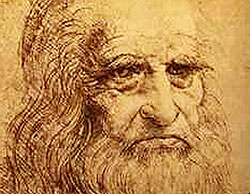
Images courtesy of NASA
Others in the next centuries took tentative steps toward flight. Various individuals tried to imitate the motion of birds and built apparatus with flapping wings called ornithopters. Sometimes they attached wings to their arms and sometimes also their legs. Some mounted winged devices that they manipulated in various ways and occasionally added foot-pedal power. Although a few were able to travel short distances, others died when they jumped off roofs or towers and they and their devices crashed to the ground. Other experimenters tried gliding rather than flapping. In general, these were more successful than the flapping efforts, although the distances were still very short. In any case, many claimed to have flown but, not surprisingly, few had witnesses or could offer proof.
The first experimenter who a ctually analyzed the various forces that contributed to flight was the Englishman George Cayley at the end of the eighteenth century. Cayley identified and defined the forces of flight and sketched out an airplane that had the primary elements of a modern aircraft. Cayley defined the principles of mechanical flight and stated that, to fly, it was necessary for surfaces to be able to support a weight by applying "power to the resistance of air." In other words, the force that moved an object in a forward direction had to be greater than the opposite force (resistance or drag) that the air exerted on an object. His "On Aerial Navigation" was one of the important early works on aviation. He also introduced the scientific method to the study of aviation-stressing careful analysis of problems and thorough testing. In the mid-nineteenth century, he demonstrated these principles with glider models that actually were able to carry the weight of a passenger a short distance. Cayley also experimented with variously shaped wings and demonstrated the importance that wing shape had on the ability of an aircraft to generate the lift that kept it afloat.
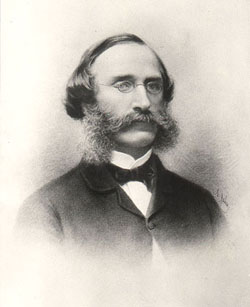
Photo courtesy of the National Air and Space Museum Credits - © 2001 National Air and Space Museum, Smithsonian Institution (SI Neg. No. A-10875)
Cayley's work influenced inventors for at least the next fifty years. Both unpowered gliders and airplanes that were powered by engines were attempted. Gliders were built that progressively could fly farther and farther and over which the pilots gradually gained control. Some of these gliders were outlandish-looking devices with various types of wing designs that had one, two, three, or even more flying surfaces. Some had short stubby wings while others had wings that were extremely long and narrow. In France, the founding of the first aeronautical society, the Sociéte Aérostatique et Météorologique de France, in 1852, marked the recognition of aviation as a legitimate discipline. Louis Charles Letur built and tested a parachute-glider, which was the first pilot-controlled machine to be tested in flight. Michel Loup, Jean-Marie LeBris, and others built flying machines that were modeled after birds.
Inventors added engines to their gliders or balloons to provide forward motion as they became available or built new designs that were meant to use the power provided by an engine. The first engines were steam-driven and generally were too heavy to provide enough power for effective lift in relation to the weight of the apparatus they were meant to power. In England, William Henson designed and patented the Aerial Steam Carriage, a powered device that was based on Cayley's doctrines. It was never built, but the steam engine that was designed to power it was judged the best that had been built up to that time.
However, inventors had more success when an engine was used with a balloon. The year 1852 marked the first time a powered device had been applied to an airframe-in this case, it was Henri Giffard's airship that was driven by a three-horsepower steam engine. Two decades later, Félix Du Temple built a steam-powered monoplane that managed to rise a few feet off the ground-the first powered fixed-wing aircraft that carried a passenger, albeit down a slope. Thomas Moy built an Aerial Steam Carriage that was a monoplane powered by a steam engine that lifted a few inches off the ground. These aircraft displayed various types of propeller assemblies that were all sizes. Other inventors, such as Alphonse Pénaud, used twisted rubber strips, basically a rubber band, to propel their flying machines. He developed theories about wing contours that he successfully applied to model airplanes, helicopters, and ornithopters. He also designed an amphibian monoplane that anticipated features that were implemented later. But he committed suicide before the design took real shape. Others used compressed air to generate thrust, and one inventor used gunpowder to power a propeller. Others reshaped wing to make them more aerodynamically effective and generate more lift.
The final advances before the achievements of the Wright brothers took place in Europe in the last decade of the nineteenth century. The first was that of the French inventor Clément Ader who flew one machine more than 150 feet (50 meters) but only inches off the ground and a second about ten feet (three meters) off the ground. He claimed he was the first to fly, but others categorized his achievements as mere "hops."
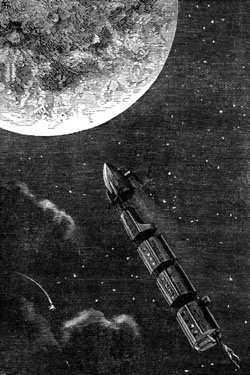
Image from clipart.com
The second, and more significant development, was that of the German engineer Otto Lilienthal, who was the first to launch himself into the air and fly. He built monoplane, biplane, and triplane gliders--eighteen variations in all--and conducted experiment after experiment that tested their flying abilities. He earned the title the "father of aerial testing" with his more than two thousand glider flights, some which covered distances of over a thousand feet (300 meters) before he died as a result of a crash landing in 1896. The American Octave Chanute also was a major figure at the end of the nineteenth and beginning of the twentieth centuries. Chanute, a respected and successful engineer and bridge builder, documented the efforts of others who had experimented with aviation, whether they had been successful or were abject failures. He was the first aviation historian and lent his considerable reputation and analytical skills to publicizing and adding respectability to the burgeoning discipline. He also constructed and flew gliders with his colleague Augustus Herring along the shores of Lake Michigan near Chicago, Illinois. Chanute served as a friend and mentor to the Wright brothers and encouraged them in their efforts.
The final unsuccessful attempt at powered flight occurred in the United States. Samuel Pierpont Langley, astronomer and secretary of the Smithsonian Institution in Washington, tested several small models that were powered by gasoline engines. These were successful and he was encouraged to try a full-size airplane called an Aerodrome. He attempted two launches in 1903, just days before the Wright brothers made their first powered flight, from a houseboat anchored in the Potomac River near Washington, D.C. Both attempts were unsuccessful.
Aside from the airplane, the aerial explorers of balloons and lighter-than-air (LTA) airships also deserve mention in the prehistory and history of aviation. The balloon predated the airplane by more than a century, and like the airplane, was used for both scientific study and military observation. The later LTA airships were a continuation of the idea of using buoyancy in transporting people, materials, and even weapons, through the air.
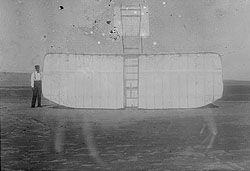
Photo courtesy of Wilbur and Orville Wright Papers, Manuscript Division, Library of Congress, Washington, D.C.
Balloons
Airplanes are heavier than air and fly because of the aerodynamic force generated by the flow of air over the lifting surfaces. Balloons and airships are lighter-than-air (LTA), and fly because they are buoyant, which is to say that the total weight of the aircraft is less than the weight of the air it displaces. The Greek philosopher Archimedes (287 BC - 212 B.C.) first established the basic principle of buoyancy. While the principles of aerodynamics do have some application to balloons and airships, LTA craft operate principally as a result of aerostatic principles relating to the pressure, temperature and volume of gases. A balloon is an unpowered aerostat, or LTA craft. An airship is a powered LTA craft able to maneuver against the wind.
There are only two practical methods of producing a buoyant aircraft. If the air inside a suitably large and lightweight envelope is heated to a high temperature, the gas expands and a sufficient amount of fluid (air is a fluid) may be forced out of the interior so that its weight decreases and the total weight of the craft becomes less than the amount of fluid (or air) displaced. Hot air balloons were flown by the brothers Joseph and Etienne Montgolfier as early as the spring of 1783. While the materials and technology are very different, the principles used by the earliest eighteenth-century experimenters continue to carry modern sport balloons aloft. Since 1960, hot air sport airships have also been constructed.
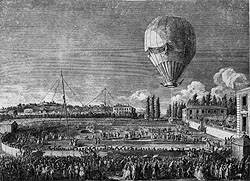
Picture courtesy of Clipart.com
The other means of achieving buoyant flight is to fill the envelope with a gas that is sufficiently lighter than air. The first hydrogen-filled balloon was designed and constructed by Jacques A.C. Charles and launched from the Champs de Mars in Paris on August 27, 1783. Jean Pierre Blanchard, a French aeronaut, made the first free flight with a gas balloon in the United States from Philadelphia in January 1793. First-generation aeronauts quickly realized that hydrogen balloons would remain in the air longer, and fly higher and farther, than hot-air balloons. The basic elements of gas balloon technology fell quickly into place. A valve at the top of the balloon, controlled by a valve line dropping through the appendix of the balloon into the basket, is used to release gas, making the balloon heavier and causing it to descend. Jettisoning a small amount of ballast, usually water, shot, or sand, would lighten the balloon and cause it to rise. A combination hot air and gas balloon is called a Rozier balloon, in honor of it inventor, Pilatre de Rozier, who with Francois Laurent, the Marquis d´Arlandes, was the first human being to make a free flight.
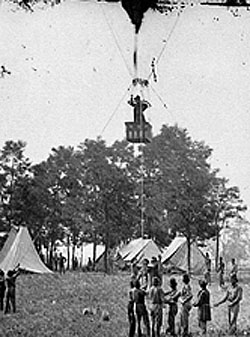
Fair Oaks, VA--Prof. Thaddeus S. Lowe observing the battle from his balloon Intrepid during the Penisular Campaign of the American Civil War, May-August 1862.
While there were no revolutionary changes in free balloon technology until the development of the hot-air sport balloon following World War II, there were significant refinements during the nineteenth century. In Europe and America, city illuminating gas was commonly used where possible rather than hydrogen. In cases where inflation was undertaken in rural areas of towns where illuminating gas was not available, portable hydrogen generators were often used. The best known of these was produced by the American Thaddeus S.C. Lowe, who pioneered observation ballooning with the Union Army during the Civil War. The use of the drag rope was commonly adopted to assist in maintaining a fairly constant altitude close to the ground. A long line was allowed to drag on the ground behind a balloon in flight. When the balloon rose, it lifted additional rope, and weight, off the ground, slowing its rise. If the balloon began to drop, it would trail additional line on the ground, reducing the weight of the craft and slowing the descent.
Balloons served a variety of purposes in the eighteenth and nineteenth centuries. They provided a spectacular means of public entertainment throughout this period. Show people who dazzled ground-hugging spectators with their death-defying feats of aerial daring-do were popular in both Europe and America. Attempts to put tethered balloons to work as battlefield observation platforms began with the wars of the French Revolution and continued through World War I. There can be little doubt, however, that the balloon was most successfully used gathering scientific information on the upper atmosphere. From the beginning of the nineteenth century to the dawn of the space age, the balloon carried instruments and human beings to the roof of the atmosphere. The most important change in ballooning in the twentieth century was the introduction of inert helium as the primary lifting gas for American balloons and airships. As the United States controlled the entire world's supply of helium, other nations continued to fly with inflammable hydrogen.
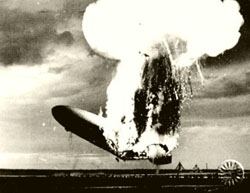
Photo by Arthur Cofod Jr., photo courtesy of the United States Air Force
Science and sport remain the most common applications of ballooning today. Balloons remain meteorological workhorses and continue to carry instrument packages aloft for short and long-term voyages into the atmosphere. Hot air balloons are an important part of modern sport aviation. Finally, the highly visible attempts to accomplish one record after another, from nonstop crossings of the oceans, to altitude records, to flights around the globe, capture the imagination of the press and public. Aerostation, the oldest form of flight, is alive and well and as capable of exciting public interest and enthusiasm as it was two centuries ago.
Airships
The dream of a navigable, or dirigible, balloon can be traced to the late eighteenth century. Not until the middle years of the nineteenth century were the first serious attempts made to realize that dream, however. A French experimenter, Henri Giffard, is usually credited with flying the first primitive airship in 1852. Airships are traditionally divided into three classes: rigid, semi-rigid and non-rigid. Non-rigid airships, or pressure airships, depend on the internal pressure of the gas in the envelope to maintain their shape. The blimps so familiar to viewers of major sporting events are pressure airships. Semi-rigid airships are pressure airships with a rigid keel structure.
Beginning in the last quarter of the nineteenth century, French constructors were active and successful in the design and operation of very large semi-rigid military airships. During the period 1900-1906, small, usually single-person, blimps of the sort popularized by the Brazilian Alberto Santos-Dumont were used to entertain mass audiences in Europe and America. It was the emergence of the German Zeppelin during the years 1900-1913 that marked the genuine coming of age of the rigid airship, however.
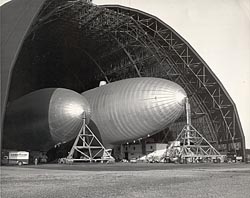
Blimps in airdock, 1973
Vehicles of commerce and weapons of war, Zeppelin airships offered the first practical means of transporting very heavy loads over very long distances through the air. As such, they served as transitional vehicles, performing a variety of duties from bombing enemy cities to providing transoceanic passenger service in an era when those tasks were beyond the capability of heavier-than-air craft. The era of the great rigid airship came to an end before World War II, when airplanes were able to carry substantial payloads over transoceanic distances at far higher speeds. Ultimately, basic technological limitations led to the demise of the rigid airship. The catastrophic destruction of the airship Hindenburg by fire in May 1937 marked the effective end of the rigid airship, although the dream of reviving the era of the "ships in the sky" continues to capture the imagination of enthusiasts.
Blimps continued in service with the U.S. Navy through World War II and into the era of the Cold War before being dropped from the inventory. Pressure airships continue to thrill spectators and to serve the needs of the media and advertisers. Proponents of the rigid airship continue to search for an economic niche that would justify a return of the large rigid airship.
This essay, titled in its original form The Prehistory of Powered Flight--an Overview by Judy Rumermancan be found in its original form on the U.S. Centennial of Flight Commission's website. Added to this essay is another one, slightly edited here, which can also be found in its original form on the U.S. Centennial of Flight Commission's website, titled Lighter-Than-Air-an Overview, by Tom D. Crouch, Senior Curator, Aeronautics, National Air and Space Museum, Smithsonian Institution.
Visit the National Park Service Travel American Aviation to learn more about Aviation related Historic Sites.
Last updated: August 22, 2017
